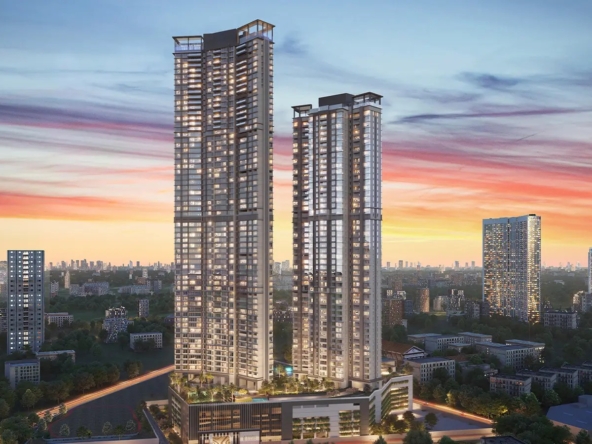Amid a broad slowdown in India’s housing sector, Mumbai Housing Market has bucked the trend, posting the highest property registration figures in over a decade. Nationwide, housing sales cooled sharply in April–June 2025, with analysts reporting roughly a 19–20% year-on-year decline in the top cities. In stark contrast, data from Maharashtra’s revenue department show that Mumbai’s property registrations in the first half of 2025 jumped to levels not seen since 2013, reflecting unusually strong demand and record revenues.
National Housing Demand Cools Sharply
Industry reports paint a gloomy picture for the housing market across most of India. For the April–June quarter of 2025, sales of new homes in the country’s largest cities fell well below the 100,000‑unit mark – a level not breached since 2021. PropEquity, a leading analytics firm, estimated that sales in the nine major cities plunged about 19% to roughly 94,864 units in Q2 2025. Similarly, data from real estate tracker ANAROCK showed sales in the top seven cities fell 20% year-on-year in Q2 2025 to about 96,285 units (against ~120,000 units a year earlier). Analysts attributed the downturn to rising home prices, higher borrowing costs and geopolitical uncertainties that have pushed many buyers into a “wait-and-watch” mode. (Notably, Chennai was the only major city to buck this trend in Q2, posting an 11% sales increase.)
In short, virtually every segment of the Indian housing market showed softening demand in the April–June quarter. Yet Mumbai – the country’s financial capital – told a very different story.
Mumbai Defies the Trend with Record Registrations
Despite the national slowdown, Mumbai Housing Market has surged. Official figures for the first six months of 2025 (January–June) reveal an all-time high in property registrations. According to the Maharashtra Inspector General of Registrations and Stamps (IGR), a total of 75,982 homes were registered in Mumbai in H1 2025, marking a 5% year-on-year increase and the strongest half-yearly performance since 2013. To put this in perspective, roughly 76,000 properties is by far the highest tally in ten years. In fact, construction industry media confirm that these 75,982 registrations set a new decade-high for Mumbai.
This surge in transaction volume translated into a record rise in stamp-duty revenue. Mumbai collected about ₹6,727 crore (Rs 67.27 billion) in registration fees and stamp duties during H1 2025, up 15% from a year ago. It is worth noting that this increase in government revenue far outpaced the modest 5% jump in unit sales, indicating that many of the new deals were higher-value transactions.
Key highlights of Mumbai’s first-half performance include:
- Record Registrations: ~75,982 property deals registered (Jan–Jun 2025), a 5% YOY rise and the highest H1 count in a decade.
- Surging Revenues: Stamp-duty collections reached ₹6,727 crore in H1 (a 15% YOY increase) – the most revenue Mumbai has seen in six months since at least 2013.
- Steady Monthly Pace: Each month saw over 11,000 registrations. For example, June 2025 had 11,586 transactions (nearly flat vs. June 2024’s 11,673).
- Robust Luxury Demand: Homes priced above ₹5 crore (approximately $600,000) accounted for 6% of June’s registrations, up from 5% a year earlier.
- Affluent Suburbs Lead: The Western and Central suburbs of Mumbai together contributed 88% of all registrations in June 2025, up from 86% a year ago.
These figures highlight that not only were more people buying homes in Mumbai this year, but the average ticket size of those sales was rising as well. According to analysts at Knight Frank India and others, this growth was “driven by a rise in high-ticket-size transactions” and sustained interest from end-users.
Stamp Duty Revenue Jumps 15%
The disproportionate increase in stamp duty revenue underscores the premium nature of recent sales. Mumbai’s state treasury earned about ₹6,727 crore from registrations in H1 2025. This compares with roughly ₹5,850 crore in the same period of 2024 – a 15% jump. June 2025 alone brought in approximately ₹1,031 crore, up 2% from June 2024.
Analysts note that these record fees were largely fueled by a higher share of large-ticket transactions. Sales of luxury apartments and villas have been particularly strong, which both lifts the average value of each sale and boosts the tax paid. As one market watcher put it, “the increase in high-ticket registrations signals wealth creation and a strong appetite for aspirational living”.
Strong Uptake in Premium Housing
A closer look at the data reveals a clear shift towards premium and luxury homes. In June 2025, properties costing over ₹5 crore made up 6% of all Mumbai registrations, up from 5% in June 2024. This segment includes large apartments, penthouses, and high-end villas. By contrast, mid-priced homes in the ₹1–5 crore range saw a relative decline in market share.
Experts say this reflects two parallel trends. On one hand, high-net-worth buyers continued to upgrade or invest in Mumbai real estate, seeking spacious homes in well-connected neighborhoods. On the other hand, entry- and mid-level buyers remained more cautious amid higher interest rates and prices. As Shishir Baijal, Chairman of Knight Frank India, observed: “Mumbai’s residential market continues to reflect steady buyer confidence…While we’ve seen some cooling in the mid-price segments, the appetite for larger homes and properties priced above ₹5 crore remains strong, driving healthy revenue collections”.
This shift is also evident in recent project launches. Developers have introduced new luxury communities and large-format apartments in suburbs like Powai, Goregaon and Thane, and these projects are garnering brisk interest. For example, one of India’s largest builders, DLF, recently secured approval from the Maharashtra regulator (MahaRERA) for its first residential project in Andheri West – a sign that major firms are confident of demand even in high-end pockets.
Monthly Sales Trends
Looking month by month in the April–June quarter, Mumbai maintained a remarkably consistent pace of deals. Each month in Q2 saw over 11,000 registrations, a level that has now been sustained for several quarters. June 2025 recorded 11,586 registrations, almost unchanged from June 2024. The small 1% drop in transaction count was offset by a rise in revenue, reflecting that June sales skewed towards more expensive units.
This steady throughput suggests that sales were driven by genuine end-user demand rather than one-off market distortions. In fact, March 2025 had already set a record for quarterly registrations (driven by an impending duty hike), but even after that rush, the momentum carried into Q2. As one industry executive noted, Mumbai “achieved the strongest performance in over a decade” in H1, with solid activity continuing into the summer months.
Suburbs Remain Market Powerhouse
Geographically, the surge in sales was broadly based across the city. The western suburbs (including Andheri, Goregaon, Malad, etc.) accounted for about 57% of all registrations in June, while the central suburbs (Ghatkopar, Chembur, Thane etc.) accounted for 31%. Together, these areas comprised roughly 88% of the market. By comparison, South Mumbai – traditionally the “prime” market with localities like Colaba and Malabar Hill – accounted for only about 6% of June’s registrations, down from higher levels in past years. This reflects the continued strength of Mumbai’s suburban hubs, where new infrastructure and spacious projects have drawn buyers.
In short, Mumbai’s growth in H1 2025 was not confined to one corner of the city but was evident across most of its catchment area. The strong performance of the suburbs underscores the ongoing shift in demand towards modern residential enclaves outside the old city core. As a senior industry official noted, “The preference for the Western and Central suburbs reiterates the role of infrastructure-led development and better connectivity in driving homebuyer sentiment”.
Analyst Perspectives and Market Outlook
Market analysts and industry leaders say Mumbai’s exceptional first-half performance demonstrates both resilience and latent buyer confidence. NAREDCO Maharashtra President Prashant Sharma commented that the city’s 2025 results “clearly reflect the market’s resilience and the underlying strength of real estate demand”, highlighting that a 5% growth in volume combined with a 15% revenue surge was evidence of “sustained end-user interest and movement in higher-ticket-size segments”. Similarly, Nishant Deshmukh of Sugee Group called the results the “strongest performance in over a decade,” noting that “the slight moderation in June is a healthy sign of market stability” and emphasizing the importance of the luxury segment to current growth.
Knight Frank’s Shishir Baijal also pointed out that Mumbai’s steady sales – remaining above 11,000 registrations each month – signal firm buyer confidence. In his view, the city’s “strongest half-yearly performance in over a decade” has been driven by “sustained demand” and a thriving luxury segment. He added that this robust activity is contributing healthy revenue collections for the state treasury, which provides a fiscal boost to government coffers.
Looking ahead, most experts remain cautiously optimistic. While interest rates have been high and many homebuyers are price-sensitive, the early 2025 data suggest that Mumbai’s housing market is holding its own. Some analysts believe that if lending rates ease and developers continue to offer attractive new projects, the demand could broaden further into the mid-income segment. For now, however, Mumbai stands out as an outlier: housing demand might have waned elsewhere in India, but in Mumbai it’s stronger than it has been in years.
Data Points (Mumbai H1 2025)
- Total registrations (Jan–Jun 2025): ~75,982 units (up 5% YoY).
- Stamp duty revenue (H1): ₹6,727 crore (up 15% YoY).
- June 2025 registrations: 11,586 units (down 1% YoY).
- June 2025 revenue: ₹1,031 crore (up 2% YoY).
- Luxury share (June): 6% of registrations above ₹5 crore (was 5% in June 2024).
- Suburban share (June): Western + Central suburbs 88% of registrations.
These figures together underscore a robust first half for Mumbai’s residential market, marking a sharp divergence from the broader national trend of muted housing demand. As one industry veteran observed, “The Mumbai market has once again demonstrated its robustness”, with rising volumes and revenues signaling “sustained buyer confidence” even amid economic headwinds.
Sources: Maharashtra IGR registration data and industry analyses, as reported by leading real estate publications and consultancies.





